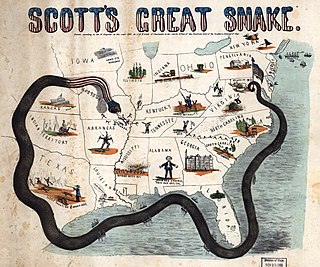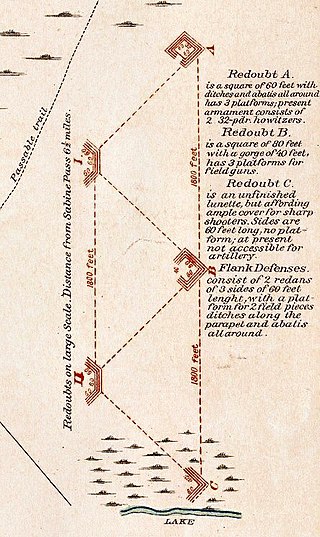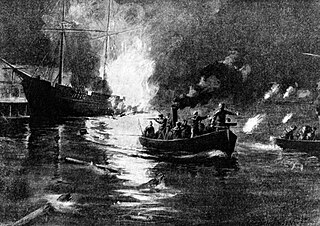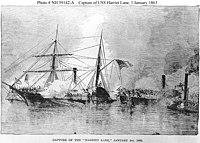
USS Katahdin was a Unadilla-class gunboat built for the U.S. Navy during the American Civil War.
William Bainbridge Renshaw was an officer in the United States Navy during the American Civil War. He was killed during the Second Battle of Galveston.
Edward Lea, was an officer in the United States Navy during the American Civil War. He was mortally wounded at the Battle of Galveston and died in the arms of his father, who was on the opposing side in the conflict.

John Bankhead Magruder often referred to as "Prince John Magruder", was an American and Confederate military officer. A graduate of West Point, Magruder served with distinction during the Mexican–American War (1846–1848) and was a prominent Confederate Army general during the American Civil War (1861–1865). As a major general, he received recognition for delaying the advance of Maj. Gen. George B. McClellan's Army of the Potomac, during the 1862 Peninsula Campaign, as well as recapturing Galveston, Texas the following year.

Harriet Lane was a revenue cutter of the United States Revenue Cutter Service and, on the outbreak of the American Civil War, a ship of the United States Navy and later Confederate States Navy. The craft was named after the niece of senator and later United States President, James Buchanan; during his presidency, she acted as First Lady. The cutter was christened and entered the water for the Revenue Service in 1859 out of New York City, and saw action during the Civil War at Fort Sumter, New Orleans, Galveston, Texas, and Virginia Point. The Confederates captured her in 1863, whereupon she was converted to mercantile service. Union forces recaptured her at the end of war. The U.S. Navy declared her unfit for service and sold her. New owners out of Philadelphia renamed her Elliot Ritchie. Her crew abandoned her at sea in 1881.
USS Westfield was a sidewheel steam ferryboat in the United States Navy during the American Civil War.
The trans-Mississippi theater of the American Civil War was the scene of the major military operations west of the Mississippi River. The area is often thought of as excluding the states and territories bordering the Pacific Ocean, which formed the Pacific coast theater of the American Civil War (1861–1865).

The lower seaboard theater of the American Civil War encompassed major military and naval operations that occurred near the coastal areas of the Southeastern United States: in Alabama, Florida, Louisiana, Mississippi, South Carolina, Texas, Port Hudson, Louisiana, and points south of it.

Joseph Nicholson Barney was a career United States Navy officer (1835–1861) who served in the Confederate States Navy in the American Civil War (1861–1865).
The second United States Navy vessel to bear the name, USS Sachem was a screw steamer built in 1844 at New York City, where the U.S. Navy purchased her on 20 September 1861.

C.S. Army Gunboat Bayou City (1861–1865) was a 165-foot side-wheel steamboat built for commercial use at Jeffersonville, Indiana, in 1859.

C.S. Army Tug Neptune was a wooden tugboat taken over by the Confederate States Army in about 1862 for the Texas Marine Department. She was employed as a tug, transport, and lookout vessel in the vicinity of Galveston, Texas.

The Battle of Galveston Harbor was fought at Galveston, Texas on October 4, 1862, during the American Civil War. After attempts to blockade the Texas coastline were unsuccessful, the Union Navy decided to attempt to capture the port of Galveston. While Galveston was defended by Confederate forces, most of the cannons in the city's defenses were removed, as Galveston was thought to be indefensible. On October 4, five Union naval vessels commanded by Commander William B. Renshaw approached Galveston, and a single ship, USRC Harriet Lane was sent into Galveston Bay under a flag of truce.
Cottonclads were a classification of steam-powered warships where a wooden ship was protected from enemy fire by bales of cotton lining its sides. Cottonclads were prevalent during the American Civil War, particularly in the Confederate States Navy for riverine and coastal service such as in the battles of Memphis, Galveston, and Sabine Pass. Confederate tactics generally had cottonclads, which were outgunned by Union warships, steam at full speed towards enemy vessels, relying on the cotton to absorb fire. Once they were within firing range, they would open fire, and, if possible, ram or board the enemy.
USS Granite City was a Confederate blockade runner steamer captured in March 1863 by the Union Navy during the American Civil War. She was armed with cannon and by August 1863 was in service as a gunboat in support of the Navy blockade of Confederate waters. She was recaptured in January 1864 by Confederate forces, again became a blockade runner, and ultimately was abandoned as a wreck after running aground.

Fort Manhassett was a group of earthen fortifications that guarded the western approaches to Sabine City, Texas during the American Civil War, operating in service of the Confederate Army from October 1863 to May 1865.
The Texas Marine Department (1861–1865) was formed in the State of Texas shortly after Texas came under blockade from the Union Navy in 1861. It operated under the control of the Confederate Navy during the Civil War.

Leonidas R. Smith was an American steamboat captain and soldier. In the American Civil War he served the Confederate States of America as a volunteer; he was named Commander of the Texas Marine Department under General John B. Magruder. Smith was involved in most major conflicts along the Texas coast during the war, and was described by war-time governor of Texas Francis Lubbock as "undoubtedly the ablest Confederate naval commander in the Gulf waters".

The Confederate Ship Royal Yacht was a small pilot schooner captained by Commodore Thomas Chubb and partly owned by his father, Charles Chubb. It was associated with the Confederate Navy in the American Civil War (1861–1865). During the 1861 blockade of Galveston, Texas, by the Union Navy, the Royal Yacht unsuccessfully took part in the harbour's defense. On November 8, 1861, the crew was captured and the vessel set ablaze by a boarding party from the USS Santee led by Lieutenant James Edward Jouett. Although repaired and redeployed in 1862, the schooner and Commodore Chubb were later recaptured by the USS William G. Anderson on April 15, 1863.












